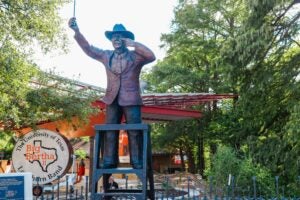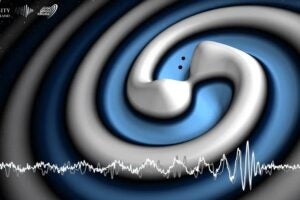Campus Kudos
$1.6 million in grants support speech-language teaching program
Two professors in the Department of Communication Sciences and Disorders have received grants totaling $1.6 million to improve treatment of culturally and linguistically diverse (CLD) children with communication disorders, such as speech-language-hearing disabilities. The grants, both from the Office of Special Education in the U.S. Department of Education, provide financial support to speech-language pathology doctoral and master’s students interested in serving school-aged children from CLD populations.
Professor gives $50,000 to School of Architecture
Professor Larry Speck, the W.L. Moody Jr. Centennial Professor in Architecture, has established the Lawrence W. Speck Endowed Graduate Fellowship in Architecture with a $50,000 gift. The endowment will be used to fund scholarships to graduate students in the master’s of architecture first professional degree program. Speck has devoted 28 years to the School of Architecture, during which time he served as the founding director for the Center for American Architecture and Design, associate dean and dean.
Prestigious award recipients honored at ceremony
Recipients of some of the most prestigious awards were recognized during a dinner hosted by President William Powers Jr. at the ATandT Executive Education and Conference Center in January. The university’s Tower glowed orange in honor of recipients of the Presidential Citation, Civitatis Award, Arno Nowotny Medal, President’s Associates Teaching Excellence Award and Chancellor’s Council Outstanding Teaching Award. To see who won each award, read the full article.
School of Architecture dean recognized by fundraising association
School of Architecture Assistant Dean for Development and External Relations Julie Hooper has been named the 2010 Outstanding Fundraising Professional by the Greater Austin Chapter of the Association of Fundraising Professionals. Hooper was honored at their Philanthropy Day Awards Luncheon celebrating Central Texas philanthropy.
School of Information professor elected to CPST Board of Directors
Professor Lecia Barker from the School of Information has been elected to the Board of Directors of the Commission on Professionals in Science and Technology (CPST). CPST collects, synthesizes, analyzes and disseminates reliable information about the U.S. science, engineering and technology workforce. Barker joined the School of Information in 2008. She studies the underrepresentation of women and minorities in the information technology workforce, as well as uses of information and communication technologies in educational settings.
School of Information receives $25,000 gift from Bowden-Massey Foundation
The Bowden-Massey Foundation has committed $25,000 to support the School of Information in the form of an unrestricted gift. The gift, from the foundation of iSchool advisory council member Virginia Bowden (Ph.D. ’94) and her husband, Charles Bowden, of San Antonio, will be available for the dean’s discretion to support excellence in the school. The Bowdens are native Texans and attended the university as undergraduates.
Press Mentions
National Geographic: True-color dinosaur pictures: First full-body rendering
Feb. 4
For the first time, scientists have decoded the full-body color patterns of a dinosaur — the 155-million-year-old Anchiornis huxleyi — a new study in the journal Science says.
That may sound familiar, given last week’s announcement of the first scientifically verified dinosaur color scheme.
But the previous research, published in Nature, had found pigments only on a few isolated parts of dinosaurs and had used less rigorous methods for assigning colors to the fossilized, filament-like “protofeathers” found on some dinosaur specimens, say authors of the new report.
The new find’s implications for the evolution of feathering and flight are “striking,” said study co-author Julia Clarke, a vertebrate paleontologist at The University of Texas in Austin.
The Wall Street Journal: Obama gets space funding right
Feb. 3
By Steven Weinberg
In the federal budget released this week, President Barack Obama calls for increasing NASA’s funding by 2 percent while cutting its manned space flight program. If enacted by Congress, the cuts will likely end plans to return astronauts to the moon. Some claim these cuts will damage America’s capabilities in science and technology, but the president’s spending plan will likely boost both.
The manned space flight program masquerades as science, but it actually crowds out real science at NASA, which is all done on unmanned missions.
Read Weinberg’s full opinion.
The New York Times: New photos, on the move, make news
Feb. 1
In the middle of December two trailer trucks left New York City bound for Austin, Texas, packed with a precious and unusual cargo: the entire collection of pictures amassed over more than half a century by the Magnum photo cooperative, whose members have been among the world’s most distinguished photojournalists.
The new owners have reached an agreement with the Harry Ransom Center at The University of Texas at Austin to place it there, for study and exhibition, for at least the next five years.
Thomas F. Staley, director of the Ransom Center said that it planned to scan every image (Magnum itself has scanned fewer than half), to begin historical research and to organize exhibitions centered on portions of the archive. “It catches so many of the world’s great photojournalists in one fell swoop,” Staley said. “These were the best of the best in their field. We want to make it a research collection. We want to bring scholars in to work in it, time and time again.”
New York Times: Appeals court throws out sentence in bombing plot, calling it too light
Feb. 2
A federal appeals court on Tuesday threw out the 22-year prison sentence imposed in 2005 on Ahmed Ressam, known as the Millennium Bomber, who plotted to set off explosives at Los Angeles International Airport on New Year’s Eve in 1999. The court said the sentence was too light.
“Some might have pointed to the relatively low sentence Ressam received as evidence that somehow civilian prosecution does not pack enough of a punch in these cases,” said Robert Chesney, an expert on national security law at The University of Texas Law School. “This reversal shows that the appellate process can police for such things, to at least an extent.”
Forbes: About $300,000 in Texas no-win BCS items for Haiti
Feb. 4
The University of Texas is sending nearly $300,000 worth of clothing to Haiti to help earthquake victims.
The 13,000 shirts and 1,000 caps were produced to celebrate a Longhorns’ victory in the Jan. 7 national championship game against Alabama. Texas lost the game 37-21.
University Co-op spokeswoman Casey Ellis says the shirts retail for $20 each, while the cap price was $22. Instead, they will be sent to Haiti on Friday with the help of various charity groups.
New York Times: Slimmer doesn’t always mean fitter
Feb. 3
In his new book, “Racing Weight: How to Get Lean for Peak Performance,” Matt Fitzgerald, a sports nutritionist, writes about an amazing running experience. He worked out on a special sort of anti-gravity treadmill, the AlterG, which uses a cushion of air to lift the body, allowing you to effectively decrease your body weight as you run.
There have been few direct tests of the body-weight effect, said Hirofumi Tanaka, an exercise physiologist at The University of Texas at Austin. Most of them were done in the 1970s and involved subjects who were asked to run with weights on their backs or ankles. Sure enough, the heavier the people were, the tests showed, the harder they had to work to run at a given speed.
Read last week’s In the Know.



